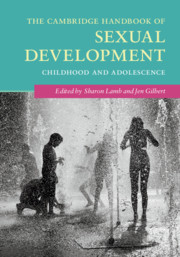Book contents
- The Cambridge Handbook of Sexual Development
- The Cambridge Handbook of Sexual Development
- Copyright page
- Contents
- Notes on Contributors
- Acknowledgments
- Introduction
- Part I What Is Sexual Development?
- Children
- 1 Are Children Sexual?
- 2 Toward a Central Theory of Childhood Sexuality
- 3 A Sociological Exploration of Childhood Sexuality
- 4 Not Innocent, but Vulnerable
- 5 The Dynamic Expression of Sexual-Minority and Gender-Minority Experience during Childhood and Adolescence
- 6 Sexual Embodiment in Girlhood and beyond
- Adolescence
- Part II How Do We Study Sexual Development?
- Part III Media, Family, Education
- Index
- References
4 - Not Innocent, but Vulnerable
An Approach to Childhood Innocence
from Children
Published online by Cambridge University Press: 27 December 2018
- The Cambridge Handbook of Sexual Development
- The Cambridge Handbook of Sexual Development
- Copyright page
- Contents
- Notes on Contributors
- Acknowledgments
- Introduction
- Part I What Is Sexual Development?
- Children
- 1 Are Children Sexual?
- 2 Toward a Central Theory of Childhood Sexuality
- 3 A Sociological Exploration of Childhood Sexuality
- 4 Not Innocent, but Vulnerable
- 5 The Dynamic Expression of Sexual-Minority and Gender-Minority Experience during Childhood and Adolescence
- 6 Sexual Embodiment in Girlhood and beyond
- Adolescence
- Part II How Do We Study Sexual Development?
- Part III Media, Family, Education
- Index
- References
Summary
- Type
- Chapter
- Information
- The Cambridge Handbook of Sexual DevelopmentChildhood and Adolescence, pp. 76 - 93Publisher: Cambridge University PressPrint publication year: 2018
References
- 10
- Cited by



